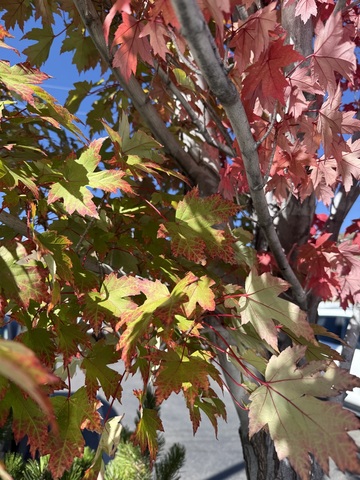
Now that fall has arrived, the hot days of summer are receding, and tree leaves are changing from green to reds, oranges, yellows and other beautiful colors. It's more pleasant to be outside.
Not only does the temperature feel more comfortable to me, but it does to my dog as well. In hot summer months, she dug through dirt in the flower bed next to my house. She made big holes as she tried to find cooler dirt to lie in. That made more work for me. I filled in holes with gravel to keep her from making spots where rainwater could gather and leak into the house.
When I'm driving, I like to watch the leaves change hue. Trees are extra beautiful when their leaves turn so many different colors. When I walked to school in third grade in Hartford, Connecticut, I used to pick up huge red and orange leaves that fell on the sidewalk. I gently clutched them, my prize possessions, walked into my classroom and gave them to my teacher. She always oohed and aahed, making it sound like I had given her the most precious gift in the entire world.
Is it just the cooler weather and different colors that make fall so special to us? On the surface, that's the biggest reason. But on a deeper level, I think fall represents change. We are leaving the heat of summer with the activities of gardening, watering flowers, and enjoying summer vacations with our families and moving into a time of change. Change isn't always easy. We need time to adjust.
We wear clothes that keep us a little warmer. That means searching through our closets to switch out summer clothing for fall attire. Fall is giving us time to get ready for bigger changes that come with winter – the below freezing temperatures, snow, more indoor activities.
In winter, we spend more time inside with our families. That can be good or not so good depending on how well we get along with family members. It signals winter outdoor activities such as skiing, snowboarding, building snowmen and having snowball fights. So much change happens in a fairly short period of time.
Some of us are better at handling change than others. Watching the leaves change color in the fall is a reminder that things are going to get quite different as the weather turns a lot colder. Fall is a time for us to get used to that change at a more leisurely pace. Nature is creating time for us to adjust in a pleasant atmosphere.
Nature, I think, is a very wise and patient teacher. It helps us learn to adjust to all kinds of change in our lives that have nothing to do with changing seasons. Changes can be painful: saying goodbye to a friend, a death in the family, a loved one getting sick for a long time, moving to a new house, a new state, or even a new country. All of those things mean big changes in our lives. They are changes we are learning to adjust to as we move from summer to autumn.
Happy fall, everyone.




